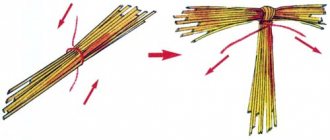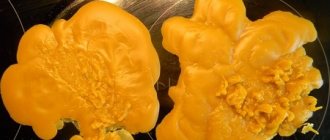Modern floor brushes and brooms have many advantages, the most important of which is versatility. Here are 7 main types of brushes and brooms for the home, which will definitely be used in every household.
The best mops for cleaning floors - which one do you choose?
What should a broom be like?
Vacuum cleaners appeared in human everyday life relatively recently, with the beginning of the development of technological progress, but it was the broom that was and remains to this day the very assistant that makes it easy to keep the floor clean.
History of the floor broom
A traditional broom is a bunch of branches or twigs, used for cleaning apartments and houses, and sometimes even local areas. Although the device for sweeping streets is usually called a broom, it is still the closest relative of an ordinary broom. Previously, these bundles of twigs were also used for cleaning wardrobe items, spraying flowers or linen - the broom was simply dipped in water, and housewives fanned with it what needed to be moistened.
Broom for sweeping the floor
Typically, twigs of shrubs or stems of herbaceous plants up to 50 cm long are used to make a broom. They are secured to a short or long handle using special strands, twine, soft branches of trees and shrubs or wire.
On a note! From Old Church Slavonic, Czech and Slovenian languages, broom is translated as “bun”. This is reported in the etymological dictionary of M. Vasmer.
Sweeping the floor
Now a broom can be made from both natural and synthetic materials. Previously, their creation was carried out by people called brooms. Currently, there are large-scale industrial productions - brooms go on sale from conveyors, have become mass products, and their production has certain standards regulated by the document OST 56-31-91.
OST 56-31-91. Sorghum brooms. Technical conditions. Downloadable file (click the link to open the PDF in a new window).
OST 56-31-91
Sorghum brooms
On the territory of Russia, the broom also had cultural significance. Residents believed that a brownie lived in the “crown” of the broom, and in general this object was associated with evil spirits. However, at the same time, it was also considered a talisman for the home, a person’s wealth, and was used for fortune telling.
On a note! The broom is still important in some regions. And in the village of Semeno-Alexandrovka, Voronezh region, residents create not simple devices for cleaning the floor, but real works of art, distinguished by their special beauty. The individual rods are tied here using willow twigs.
Nowadays, a broom is considered a common household tool used for cleaning the floor. It is ideal for cleaning the base from large particles of debris that can clog the vacuum cleaner and cause it to fail. As a rule, a broom is used at one of the stages of major cleaning - first they walk across the floor with it, then they pick up a vacuum cleaner, then comes the final stage of cleaning - washing the floor with a rag.
The broom is still used today
A good broom should be durable and neat in appearance. It is not recommended to use it for a long time - it is usually thrown away approximately 10-12 months after purchase. The fact is that if it is made from natural raw materials, the branches dry out and begin to crumble over time. Thus, during cleaning, the broom itself produces more garbage than it is useful.
Where it should always be clean so that money doesn’t go away
In order for wealth to fill the house, you need to make room for it. Do regular cleaning. Remove clutter, clear space.
The kitchen and hallway are special places that should always be clean.
Cuisine is concerned with preparing and eating food. And food has always been considered a sign of prosperity. The richer and more varied the table, the richer the family. This is a place of concentration of monetary energy, which should circulate freely without coming into contact with dirt.
Money can flow with water. Make sure that in the kitchen, the place where wealth is concentrated, the taps are in working order.
The hallway is the border between our home world and the outside world. There shouldn't be any trash here.
Immediately wash the shoes you came in and remove external negativity from them.
To prevent your money from going away, immediately put your shoes on a shelf or in a closet.
5 things you can't share after a divorce
Remember that you need to clean the apartment during the day, making room for positive, bright flows, including money.
What are floor brooms made of?
Throughout its centuries-old history, the broom has remained virtually unchanged in appearance - only the materials from which it is made have changed. You can make this cleaning device out of almost anything. Basically, brooms are made from stems and branches of bushes and herbs, and twigs. Most often they are created from a special plant - sorghum, but we will talk about it a little lower.
To create brooms, the stems of a plant such as chiliga or wild acacia can be used. It has quite strong and flexible shoots. But such a broom is not suitable for cleaning the house because of its density and roughness.
One of the modern broom options
Brooms are also knitted from common wolfberry, a shrub popularly called “wolf berry.” By the way, this is the plant that produces the popular goji berries. But a soft broom can be made from St. John's wort, wormwood, and oregano. If you sweep the floor with such a product, the house will smell fragrant, and moths and other insects will not appear. Spiders could be expelled from a home by sweeping it with a broom made of reed stems. In villages they still use brooms made from nettles and linden branches.
The Slavs often used millet stems to create brooms. But now such products have practically sunk into oblivion - they have been replaced by softer brooms made from broom sorghum.
You can even make good money making brooms
Rubber floor brush
A good option for those who need to quickly clean up their apartment without resorting to a vacuum cleaner or mop. The bristles of such a brush do not bend, which allows you to quickly clean even a carpet with a very long pile from debris.
The main advantage: all the dirt easily sticks to the rubber fluffs, so the cleaning process is accelerated many times over.
The brush is also suitable for carpet and smooth surfaces.
Average cost: 1000-2000 rubles.
What is a house broom made of?
Natural raw materials have always been in price. It is environmentally friendly and does not pose a health hazard. That is why natural brooms made from broom sorghum are still used. It is also sometimes called economic.
Sorghum is an annual plant native to hot Africa. However, now it grows in India, America, Europe, Asian countries and Russia. This plant is drought-resistant, is not afraid of lack of moisture, is generally unpretentious in care, and loves warmth. Sorghum has a strong stem that is excellent for broom production.
Sorghum (lat. Sorghum)
To make brooms, only mature branches of this plant are used - a kind of panicles. In a temperate climate, they still do not have time to grow, so most of the brooms, one might say, come from the south. The highest quality products are obtained from stems that end their life and dry out on the root. Also, the best raw materials have reddish panicles and red or brown grains. Some growers even leave them on the branches to prove the quality of their product.
On a note! Not only brooms are made from sorghum. The plant is excellent for making paper, starch, and silage. In terms of nutritional properties, it is no worse than corn.
Sorghum can be used for more than just making brooms
From a business perspective, sorghum is a profitable investment. It grows well, and from 1 hectare of land you can get up to 4 thousand brooms. However, this plant is very fond of pests, which adversely affects the harvest as a whole. Sorghum can ripen to the desired state already cut, which is used by broom producers in the northern regions.
Electric floor brush
Equipment for housewives who value their time.
This “device” is a hybrid of a floor brush and a vacuum cleaner. The brush has various attachments that allow you to quickly restore order even in rooms completely filled with furniture.
In most cases, such electric brushes are equipped with a removable dust container, which makes cleaning easier and more comfortable.
Average cost: 2000-4000 rubles.
What are brooms for sweeping made of nowadays? Cleaning brushes
Brooms will never go away from everyday use due to the fact that there is a certain number of floor coverings that require careful handling. These are laminate, parquet, some types of tiles (for example, vinyl), etc. In no case should they be cleaned using brute force. And a broom comes in handy here.
Nowadays brooms are also made from polymers. They may have an antistatic brush and a long plastic handle. They are convenient to work with, and such brooms are also good at collecting dirt from the floor covering. Synthetic products can be used to clean any surfaces, they do not scratch anything, do not generate dust (to avoid the dusting effect when cleaning with a regular broom, you have to wet it), they allow you to reach hard-to-reach places and sweep them well.
This is what a modern broom looks like
Synthetic brooms are used for cleaning both residential premises and local areas. They are purchased by enterprises for cleaning production areas. Their main advantage is durability compared to conventional brooms and lack of fragility.
Most often, synthetic brooms are called brushes - they just look exactly like brushes, bearing little resemblance to a standard and familiar broom. They are usually made of PVC. Their cost is greatly influenced by the quality of the raw materials, the length of the handle and bristles of the brush itself, strength and manufacturer brand.
Soft synthetic floor brush
By the way, in modern artificial brooms the length of the sweeping part (broom) has become much shorter than in their predecessor - the traditional broom. But the handle has become longer and can have a variety of configurations. These brooms are lightweight and easy to clean/storage; they can be treated and disinfected with various chemical compounds.
Table. Types of brushes.
| View | Characteristic |
| Rectangular, with long handle | A universal brush, which is used for cleaning floor coverings, cleaning hard-to-reach places, and is often used to remove cobwebs from under the ceiling. Suitable for cleaning carpets, but cleans laminate and parquet well. |
| Laminate brush | Costs more than a universal brush. It has a special pile that carefully and thoroughly cleans laminated flooring or parquet. Also suitable for sweeping away dust from blinds, radiators, etc. |
| Flexible brush | Ideal for cleaning hard-to-reach places and ceilings. It has a long pile and can bend in all directions. The pile itself is also located on a curved strip. |
Small floor brush
A very convenient tool in situations where you do not need to sweep the floor in the entire room, but only need to remove minor dirt. A similar brush usually comes with a dustpan.
It cannot treat a large surface, so you will still have to spend money on buying a more solid brush.
To ensure effective cleaning, you should pay attention to the pile - it should be short, fairly elastic and densely packed.
Average cost: 200-700 rubles.
A broom is a simple tool, but requires preparation
A newly purchased broom needs preparation before it can be used to clean the floor. And it is important to prepare it correctly so that it serves well and for as long as possible. There are no exact instructions for pre-processing a broom, but many use those that grandmothers and mothers shared with them.
Broom for sweeping
A new broom can be filled with boiling water, preferably with the addition of a small amount of salt (at the rate of about 1 teaspoon per 1 liter of water). Although some use only 2 tsp. for a 10-liter bucket - this does not make the procedure any worse. Leave the broom in a bucket of water until the liquid cools completely (at least 3 hours). Next, it is dried (preferably in a pressed state).
Advice! For ease of use, the broom whisk can be trimmed - cut it at a slight angle. Then it will be easier to handle hard-to-reach places and corners.
You also need to properly care for the broom so that it lasts as long as possible and does not deteriorate.
- It is not recommended to store this cleaning tool in an upright position. The best option is to place the broom on a horizontal surface after use. As a last resort, the broom is placed in a corner with the sweeping part up.
- Before using, it is better to soak the broom in a hot salt solution each time.
Three-stitched sorghum brooms
Soft synthetic brush
A synthetic brush with a long handle is an indispensable assistant in the household. The reliable base holds lint firmly, and the telescopic handle helps you quickly deal with dirt even in hard-to-reach places.
One of the advantages is the presence of several replaceable attachments, which can be changed depending on the type of coating or the type of cleaning (approx. - wet or dry).
Average cost: 500-1500 rubles.
How to knit brooms
Making a broom is not as simple as it seems at first glance. First of all, ripened sorghum is cut and sent for drying. It is usually done in a dry room where there is good air circulation. The drying time of the material is about 10 days. Next, the sorghum stems are cleared of leaves and excess seeds are removed - this is done with a special comb.
Brooms
Raw materials are sorted by size - length and thickness of the stems. On average, their consumption to create one broom is 20-35 pieces. The length should be about 85 cm. The width of the panicle is 25-40 cm.
The stems of the plant are tightly pulled together using metal and rubber rings and fastened with special pins. Twine, nylon, wire, and willow branches can also be used. Finished brooms are sent from production for sale.
Making a broom with your own hands
You can grow your own broom in your own garden plot. It is enough to buy sorghum seeds, and by autumn you will have the necessary raw materials. Let's get acquainted with the technology of creating a broom at home.
Step 1. To make a broom with your own hands, sorghum stalks are grown in your garden plot. Seeds are planted in the spring.
Sorghum on a personal plot
Step 2. In the fall, when the sorghum is ripe, its stems are cut off. It is easy to recognize the moment of pruning sorghum - the leaves of the plant begin to turn yellow, and the seeds acquire a reddish color.
Cut sorghum stems
Step 3. Large leaves from the sorghum stems are removed - a small panicle remains, which is hung upside down in a dry, ventilated room from the ceiling for proper drying. The drying period is about 10-30 days, but it is better to leave sorghum until spring.
Drying the stems
Step 4. Next, the seeds are removed from the sorghum stems - otherwise they will all end up in the room during cleaning. A regular metal bucket will help you cope with the seeds. A sorghum sprig is pushed into the bucket with a broom so that the metal handle of the bucket then rests on its stem. This way the handle is pressed against the bucket and the sorghum is between them. The stem stretches outward, and the seeds all remain in the bucket thanks to the bucket and handle.
Dried sorghum stalks
Removing seeds using a metal bucket
Step 5. It's time to form the broom. First, a smooth working surface of the broom is created. To do this, all sorghum stems are laid carefully on a flat surface. In this case, small branches should be inside the broom, large and powerful stems should be placed outside.
The stems should be laid straight
Laying the branches correctly
Step 6. To make a broom, you will need a rope about 2 m long, which is suspended on some kind of support. A wooden lever is tied to its lower part.
Next you will need a rope
A wooden lever is tied to the bottom of the rope
Step 7. Take a bunch of sorghum, select the place where the first knot will be located, and then make a loop of suspended rope around this place. The rope is fixed by pressing the foot on the lever. The rope is stretched and makes it possible to pull the broom as tightly as possible, which at this time rotates half a turn.
Forming a loop in place of the first knot
Step 8. After this, take a nylon thread and pass it through the middle of the sorghum bundle. At the location of the rope, the thread is wrapped around the future broom. The ends of the thread are tied after winding. After tying, the ends are passed through the middle of the bun again and pulled up. Excess threads are cut off.
The thread is passed through the middle of the bundle
The thread is wrapped around the broom
Step 9. Next, several more windings are made around the sorghum bunch in the same way.
Then you need to make several more such windings
Step 10. Excess stems are cut off using a sharp knife.
Trimming excess stems
Step 11. Next, the broom needs to be stitched. The following device is useful, created from two slats connected to each other by a piece of rubber. One of the strips has two holes, and the other has two bolts. The broom is placed between two slats and tightened with bolts. The panicle straightens out well.
This device will be used
The broom is placed between two slats
The panicle spreads out well
Step 12. The stitching will be done according to the principle of sewing shoes - with two threads and using an awl.
Let's get started with the firmware
Step 13. The broom is pierced with an awl and the thread laid at the bottom of the broom is picked up by it and pulled up. The top thread is pulled into the resulting loop. The lower thread is tightened.
Two threads are used
The thread laid at the bottom of the panicle is picked up by it and pulled up
The lower thread is tightened
Step 14. In the same way, the entire broom panicle is stitched in the selected place. The threads are tied at the end. You can knit a couple of rows for reliability. The ends of the thread are hidden inside the broom.
The entire broom panicle is stitched in the same way.
Step 15. Using the same principle, the place on the panicle located below the retaining slats is stitched. The broom is ready.
The broom is stitched in two places
Prices for brooms for cleaning
brooms for cleaning
Broom and dustpan - forever together
Mechanical broom.
More often than not, in modern homes there are products that combine both a broom and its constant companion – a dustpan. Doing your own cleaning with this tool is easy and not at all tiring. And the quality of the work done will be very high.
The principle of operation is simple: when the broom slides along the floor surface, all the litter, debris, and even very fine dust are collected in a special reservoir. After that, you just need to press a special button or unfasten it to empty it of collected debris. After this, the tool is ready for use again. (see also the article How to choose a mop for the floor)
Attention! Do not forget to recharge the battery, as most of these models run on it.











